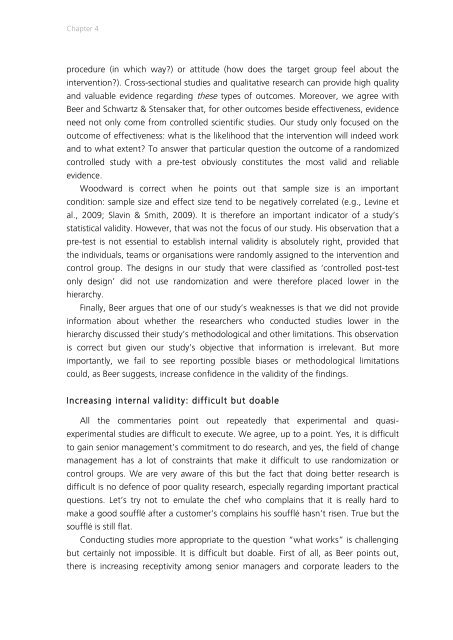In Search of Evidence
jqluvth
jqluvth
Create successful ePaper yourself
Turn your PDF publications into a flip-book with our unique Google optimized e-Paper software.
Chapter 4<br />
procedure (in which way?) or attitude (how does the target group feel about the<br />
intervention?). Cross-sectional studies and qualitative research can provide high quality<br />
and valuable evidence regarding these types <strong>of</strong> outcomes. Moreover, we agree with<br />
Beer and Schwartz & Stensaker that, for other outcomes beside effectiveness, evidence<br />
need not only come from controlled scientific studies. Our study only focused on the<br />
outcome <strong>of</strong> effectiveness: what is the likelihood that the intervention will indeed work<br />
and to what extent? To answer that particular question the outcome <strong>of</strong> a randomized<br />
controlled study with a pre-test obviously constitutes the most valid and reliable<br />
evidence.<br />
Woodward is correct when he points out that sample size is an important<br />
condition: sample size and effect size tend to be negatively correlated (e.g., Levine et<br />
al., 2009; Slavin & Smith, 2009). It is therefore an important indicator <strong>of</strong> a study’s<br />
statistical validity. However, that was not the focus <strong>of</strong> our study. His observation that a<br />
pre-test is not essential to establish internal validity is absolutely right, provided that<br />
the individuals, teams or organisations were randomly assigned to the intervention and<br />
control group. The designs in our study that were classified as ‘controlled post-test<br />
only design’ did not use randomization and were therefore placed lower in the<br />
hierarchy.<br />
Finally, Beer argues that one <strong>of</strong> our study’s weaknesses is that we did not provide<br />
information about whether the researchers who conducted studies lower in the<br />
hierarchy discussed their study’s methodological and other limitations. This observation<br />
is correct but given our study’s objective that information is irrelevant. But more<br />
importantly, we fail to see reporting possible biases or methodological limitations<br />
could, as Beer suggests, increase confidence in the validity <strong>of</strong> the findings.<br />
<strong>In</strong>creasing internal validity: difficult but doable<br />
All the commentaries point out repeatedly that experimental and quasiexperimental<br />
studies are difficult to execute. We agree, up to a point. Yes, it is difficult<br />
to gain senior management’s commitment to do research, and yes, the field <strong>of</strong> change<br />
management has a lot <strong>of</strong> constraints that make it difficult to use randomization or<br />
control groups. We are very aware <strong>of</strong> this but the fact that doing better research is<br />
difficult is no defence <strong>of</strong> poor quality research, especially regarding important practical<br />
questions. Let’s try not to emulate the chef who complains that it is really hard to<br />
make a good soufflé after a customer’s complains his soufflé hasn’t risen. True but the<br />
soufflé is still flat.<br />
Conducting studies more appropriate to the question “what works” is challenging<br />
but certainly not impossible. It is difficult but doable. First <strong>of</strong> all, as Beer points out,<br />
there is increasing receptivity among senior managers and corporate leaders to the


